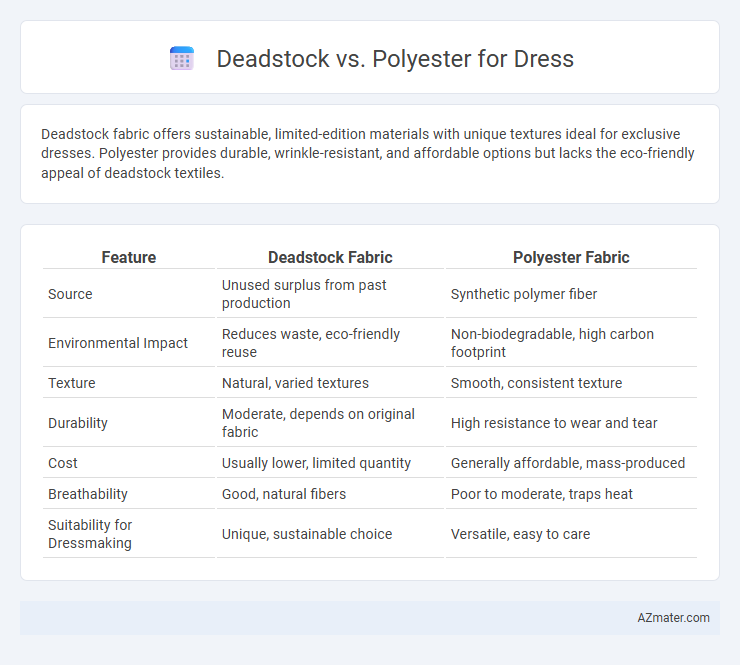Deadstock fabric offers sustainable, limited-edition materials with unique textures ideal for exclusive dresses. Polyester provides durable, wrinkle-resistant, and affordable options but lacks the eco-friendly appeal of deadstock textiles.
Table of Comparison
| Feature | Deadstock Fabric | Polyester Fabric |
|---|---|---|
| Source | Unused surplus from past production | Synthetic polymer fiber |
| Environmental Impact | Reduces waste, eco-friendly reuse | Non-biodegradable, high carbon footprint |
| Texture | Natural, varied textures | Smooth, consistent texture |
| Durability | Moderate, depends on original fabric | High resistance to wear and tear |
| Cost | Usually lower, limited quantity | Generally affordable, mass-produced |
| Breathability | Good, natural fibers | Poor to moderate, traps heat |
| Suitability for Dressmaking | Unique, sustainable choice | Versatile, easy to care |
Understanding Deadstock Fabric: An Overview
Deadstock fabric refers to unused, leftover textile material from previous manufacturing runs, often vintage and of high quality, making it an eco-friendly choice for dress production. It contrasts with polyester, a synthetic fiber derived from petroleum that offers durability, wrinkle resistance, and affordability but lacks the unique texture and environmental benefits of deadstock. Utilizing deadstock fabric reduces textile waste and supports sustainable fashion by giving new life to surplus materials otherwise discarded.
What Is Polyester? Key Characteristics
Polyester is a synthetic fiber derived from petroleum-based products, known for its durability, resistance to wrinkles, and quick-drying properties. It offers excellent color retention and is less prone to shrinking compared to natural fibers, making it a popular choice for affordable, low-maintenance dresses. However, polyester lacks breathability and can trap moisture, leading to discomfort in hot weather.
Environmental Impact: Deadstock vs Polyester
Deadstock fabric reduces environmental impact by repurposing unused textile remnants, minimizing waste and the demand for new raw materials. Polyester production relies heavily on petrochemicals, contributing to greenhouse gas emissions and microplastic pollution in water systems during washing. Choosing deadstock supports sustainable fashion by utilizing existing resources, while polyester's environmental footprint remains significant due to its synthetic origin and non-biodegradability.
Durability and Longevity in Dresses
Deadstock fabric, often made from high-quality natural fibers, offers superior durability and longevity in dresses due to its original, unused condition and robust material properties. Polyester, a synthetic fabric, provides excellent resistance to wrinkles, shrinking, and stretching, enhancing the dress's lifespan, but may degrade faster under constant heat or UV exposure. Choosing deadstock fabric ensures a sustainable option with lasting strength, while polyester delivers consistent wearability and easy maintenance over time.
Comfort and Wearability: Which Feels Better?
Deadstock fabric offers superior comfort thanks to its natural fibers, allowing better breathability and moisture absorption, making it ideal for prolonged wear. Polyester, while durable and resistant to wrinkles, tends to trap heat and moisture, which can cause discomfort during extended use. The choice between deadstock and polyester for dresses ultimately depends on prioritizing natural comfort or low-maintenance wearability.
Style and Versatility: Deadstock vs Polyester
Deadstock fabric offers unique, vintage-inspired style with limited availability, making dresses crafted from it stand out for their one-of-a-kind appeal and eco-conscious statement. Polyester dresses provide high versatility through durability, wrinkle resistance, and ease of care, allowing for a wide range of styles from casual to formal. Deadstock supports sustainable fashion with exclusivity, while polyester ensures consistent performance and adaptability across diverse occasions.
Price Comparison: Cost to Consumer
Deadstock dresses typically offer lower costs to consumers due to the reuse of surplus fabrics, making them an economical and sustainable option. Polyester dresses often have variable prices, generally lower because of mass production but sometimes higher when featuring branded or intricate designs. Consumers aiming for affordability and eco-conscious choices frequently find deadstock options more cost-effective compared to conventional polyester dresses.
Ethical Considerations in Fabric Choice
Deadstock fabric, sourced from leftover or unused materials, significantly reduces waste and environmental impact, making it an ethical choice for dress production. Polyester, a synthetic fiber derived from petroleum, contributes to pollution and microplastic release, raising sustainability concerns despite its durability and affordability. Choosing deadstock promotes circular fashion by repurposing existing textiles, aligning with eco-conscious and ethical fashion principles.
Maintenance and Care Tips
Deadstock fabric often requires gentle care, such as hand washing or using a delicate cycle in cold water, to preserve its unique texture and prevent damage from harsh detergents or high heat. Polyester is more durable and low-maintenance, typically machine washable with resistance to shrinking and wrinkles, but avoiding high heat during drying helps maintain its shape and color. Both fabrics benefit from air drying and storing in a cool, dry place to extend their longevity and keep the dress looking its best.
Choosing the Right Fabric for Your Dress
Deadstock fabric, sourced from surplus or unused textile stock, offers unique patterns and eco-friendly benefits, making it ideal for sustainable dressmaking. Polyester, a synthetic fiber known for its durability, wrinkle resistance, and affordability, ensures long-lasting and low-maintenance dresses. Selecting the right fabric depends on prioritizing sustainability with deadstock or favoring performance and budget with polyester for your dress.

Infographic: Deadstock vs Polyester for Dress
 azmater.com
azmater.com